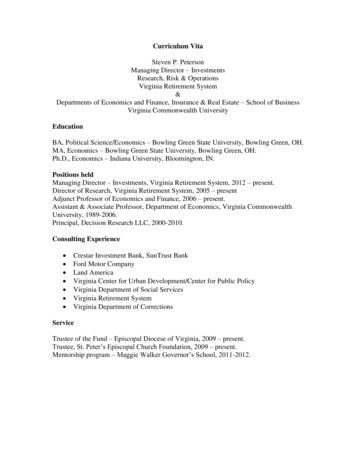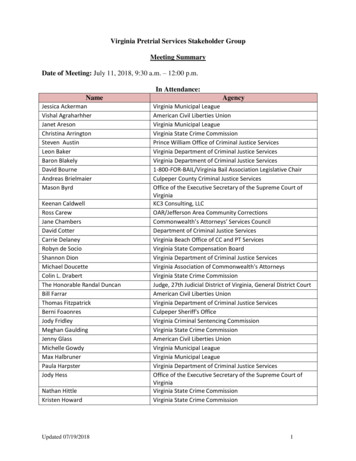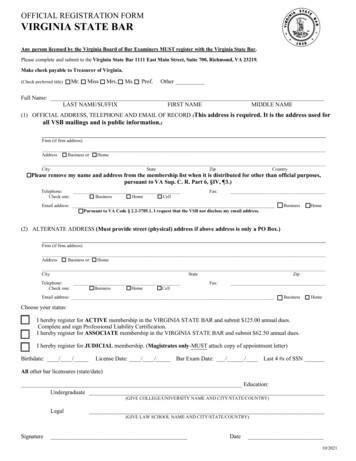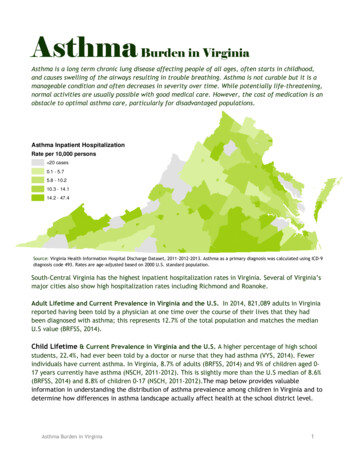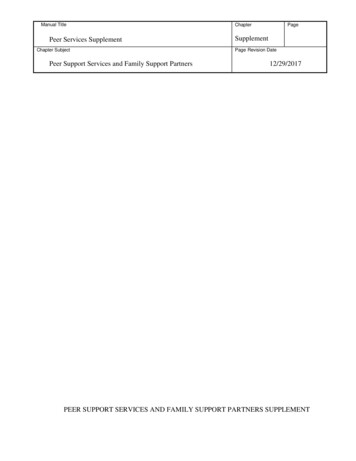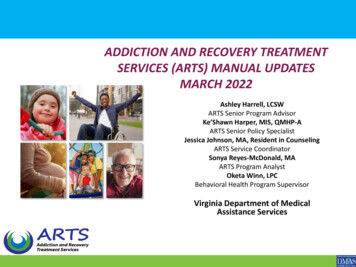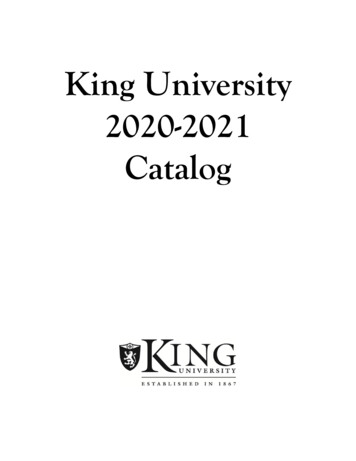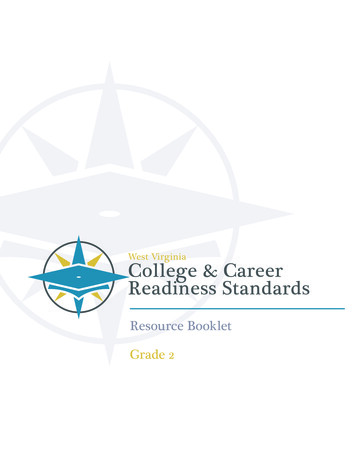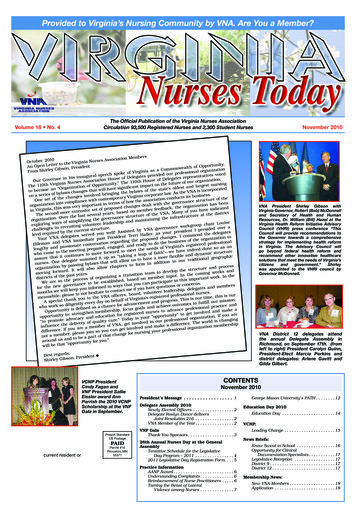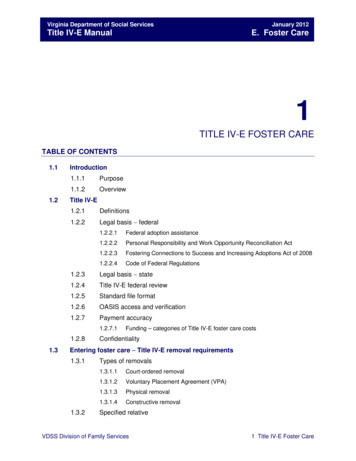
Transcription
Virginia Department of Social ServicesJanuary 2012Title IV-E ManualE. Foster Care1TITLE IV-E FOSTER CARETABLE OF wTitle IV-E1.2.1Definitions1.2.2Legal basis federal1.2.2.1Federal adoption assistance1.2.2.2Personal Responsibility and Work Opportunity Reconciliation Act1.2.2.3Fostering Connections to Success and Increasing Adoptions Act of 20081.2.2.4Code of Federal Regulations1.2.3Legal basis state1.2.4Title IV-E federal review1.2.5Standard file format1.2.6OASIS access and verification1.2.7Payment accuracy1.2.7.11.2.81.3Funding – categories of Title IV-E foster care costsConfidentialityEntering foster care Title IV-E removal requirements1.3.11.3.2Types of removals1.3.1.1Court-ordered removal1.3.1.2Voluntary Placement Agreement (VPA)1.3.1.3Physical removal1.3.1.4Constructive removalSpecified relativeVDSS Division of Family Services1 Title IV-E Foster Care
Virginia Department of Social ServicesTitle IV-E Manual1.4E. Foster menting the specified relative1.3.3Removals that do not meet IV-E requirements1.3.4Timeliness of removal1.3.4.1Timeliness considerations1.3.4.2Delayed placements into foster care1.3.4.3Physical removals prior to a judicial orderTitle IV-E application process1.4.11.4.21.5January 2012Application referral1.4.1.1Application date1.4.1.2Application processInitial evaluation1.4.2.1Evaluation process1.4.2.2Disposition of application1.4.2.3Title IV-E eligibility disposition – Notice of Action (NOA)1.4.2.4Title IV-E re-screening of initial eligibilityInitial Title IV-E eligibility screening1.5.1Judicial language requirements – court-ordered removal1.5.1.1Contrary to the Welfare (CTW) / Best Interest (BI)1.5.1.2Reasonable Efforts (RE)1.5.2Judicial language requirements – VPAs (entrustment or non-custodial fostercare agreement)1.5.2.1Contrary to the Welfare / Best Interest (CTW/BI)1.5.2.2Reasonable Efforts (RE)1.5.3Documentation for judicial determinations1.5.4AFDC relatedness1.5.4.1Verification methods1.5.4.2Citizenship/Alien requirement1.5.4.3Age requirement1.5.4.4Eligibility month1.5.4.5Removal home/living with requirement1.5.4.6Assistance Unit (AU)1.5.4.7Deprivation requirement1.5.4.8Treatment of resources1.5.4.9Income standardVDSS Division of Family Services1 Title IV-E Foster Care
Virginia Department of Social ServicesJanuary 2012Title IV-E ManualE. Foster Care1.5.4.10 Income conversion1.5.4.11 Deeming income1.5.4.12 Standard of need1.6Ongoing 6.2.1Emergency foster home placement1.6.2.2Resource family homes1.6.2.3Treatment foster home1.6.2.4Children’s residential facilities1.6.2.5Independent living arrangements1.6.2.6Interstate placements1.6.2.7Transferring custody to another LDSS1.6.2.8Placement documentationFinancial need mp sum payment1.6.3.4Receipt of Supplemental Security Income (SSI)1.6.3.5Recurring monthly benefitsAnnual Judicial Reviews (AJR)Entitlement to maintenance cost1.7.1Initial entitlement1.7.1.1Maintenance1.7.1.2Supplemental clothing allowance1.7.1.3Amount of payment1.7.1.3.11.7.21.8PlacementOngoing entitlementAssignment of support rights1.8.1Referral to Division of Child Support Enforcement (DCSE)1.8.1.1Initial application1.8.1.2Initial Good Cause claims1.8.1.3Ongoing Good Cause evaluation and status1.8.2DCSE requirements for children ineligible for Title IV-E payment1.8.3Changes that affect DCSEVDSS Division of Family Services1 Title IV-E Foster Care
Virginia Department of Social ServicesTitle IV-E Manual1.8.41.91.9.2Support collectionsMedicaid entitlement application1.9.1.1Method of application1.9.1.2Timely application1.9.1.3Late application1.9.1.4Retroactive entitlementMedicaid eligibility1.9.2.1Title IV-E eligible AND receiving a IV-E maintenance payment1.9.2.2Title IV-E eligible child is an SSI recipient (receives SSI payment)1.9.2.3Changes that affect Medicaid1.9.3Annual Medicaid renewals1.9.4Medicaid cancellation1.9.5Medicaid Notice of ActionClosure of Title IV-E case1.10.11.11E. Foster CareMedical Care – Medicaid1.9.11.10January 2012When to close a Title IV-E caseMinor child of foster care child1.11.1Referral of the absent parent to DCSE1.11.2Amount of payment1.11.3Medicaid enrollment1.11.4Completion of foster care maintenance evaluation1.11.5When not to include the minor child in their parent's (foster child’s) caseVDSS Division of Family Services1 Title IV-E Foster Care
Virginia Department of Social ServicesTitle IV-E ManualJanuary 2012E. Foster Care1TITLE IV-E FOSTER CARE1.1 Introduction1.1.1 PurposeThis manual addresses Title IV-E eligibility requirements as provided by Federalregulations (45 CFR Parts 1355 and 1356) and State statutes (Title 63.2 and Title16.1), as well as the appropriate use of Title IV-E funds for those foster care childrenwho have been found eligible for funding under Title IV-E. This manual is acompanion to the Foster Care Manual. The Title IV-E manual provides guidance andauthority specific for use of Title IV-E funds but additional guidance may also bedocumented in the Foster Care chapter.1.1.2 OverviewFoster Care is a State-mandated service provided through federal, state, and localfunds for children who have been placed in family foster homes or other types of outof-home placements as initiated by a court order, or a Voluntary PlacementAgreement, e.g., entrustments and non-custodial foster care agreements. Fostercare placement is intended to be a temporary, rather than a long-term solution tofamily problems. A placement may be with a foster family, an adoptive family, in agroup living arrangement, in a residential treatment facility, or in an independentliving arrangement."Foster care services" refers to the provision of a full range of casework, treatment,and community services for a planned period of time to a child who is abused orneglected as defined in § 63.2-100 or in need of services as defined in § 16.1-228and his family when a child: Has been identified as needing services to prevent or eliminate the need forfoster care placement.VDSS Division of Family Services1 Title IV-E Foster Care
Virginia Department of Social ServicesTitle IV-E ManualJanuary 2012E. Foster Care Has been placed through an agreement between the local board and theparent(s) or guardians where legal custody remains with the parent(s) orguardians. Has been committed or entrusted to a local board or licensed child-placingagency (LCPA) (§ 63.2-905).Federal Financial Participation (FFP) in the form of reimbursement to states forallowable foster care costs is provided under subpart E of Title IV of the SocialSecurity Act.1.2 Title IV-E1.2.1 DefinitionsThe following words and terms, when used in this policy, shall have the followingmeaning, unless the context clearly indicates otherwise:TermDefinitionAgencyA public agency or licensed child-placing agency.Any LDSS-approved provider home that gives 24-hourAgencyApproved Foster substitute family care, room and board, and services for childrenor youth.HomeAid for Familieswith DependentChildren (AFDC)The benefit program prior to Temporary Assistance for NeedyFamilies (TANF). AFDC was repealed but the AFDC Programrequirements that were in effect in Virginia on July 16, 1996,remain in effect for Title IV-E eligibility determinations.Allowable CostsThe expenses identified as reimbursable in Federal guidance.Annual JudicialReview (AJR)Court hearing and signed order held within a 12-month periodthat evaluates and approves the permanency plan for a fostercare child.Assistance UnitThe grouping of persons who were residing in the removalhome in the month of removal prior to the child’s actual(physical or constructive) removal from the home whose incomeand resources shall be considered during the eligibility monthwhen evaluating AFDC eligibility.VDSS Division of Family Services1 Title IV-E Foster Care
Virginia Department of Social ServicesTitle IV-E ManualJanuary 2012E. Foster CareTermDefinitionBest AvailableEvidenceThe allowable use of documentation that, based upon apreponderance of evidence, can be reasonably viewed tosatisfy certain Title IV-E eligibility requirements.Certificate ofApprovalThe document provided to a foster home as proof of meetingstandards for approval.Child-PlacingAgency (CPA)Any person who places children in foster homes, adoptivehomes, or independent living arrangements pursuant to § 63.21819 of the Code of Virginia or a local board that placeschildren in foster homes or adoptive homes pursuant to §§ 63.2900, 63.2-903, and 63.2-1221 of the Code of Virginia. Officers,employees, or agents of the Commonwealth, or any localityacting within the scope of their authority as such, who serve asor maintain a child-placing agency, shall not be required to belicensed.ComprehensiveServices for AtRisk Youth andFamilies (CSA)The legislation that created a collaborative system of servicesand funding that is child-centered, family-focused, andcommunity-based to address the strengths and needs oftroubled and at-risk youth and their families (§ 2.2-5200 et.seq.).Contrary to theWelfareA determination made by a judicial order with language to theeffect that continuation in the home would be contrary to thechild's welfare, or that placement is in the child's best interest.Court OrderAny order issued by a court that removes custody, approvescustody, or approves placements and conditions for foster care.This includes Petition for Removal, Emergency Removal orders,Preliminary Removal orders, Annual Judicial reviews andCHINS petitions. Nunc Pro Tunc (now for then) orders oraffidavits attesting that the judicial determination occurred at aprevious hearing court orders that change the substance of aprior judicial determination or constitute a judicial determinationnot previously made are not acceptable documentation insupport of a judicial determination.Date ChildEntered FosterCareThe earlier date of a judicial finding of abuse or neglect or 60days from the date the child is physically removed from thehome.VDSS Division of Family Services1 Title IV-E Foster Care
Virginia Department of Social ServicesTitle IV-E ManualJanuary 2012E. Foster CareTermDefinitionDeemingThe procedure to evaluate income of an individual living in theremoval home who is not included in the AFDC assistance unitbut whose income may be considered available to the AFDCassistance unit.Department (orVDSS)The Virginia Department of Social Services.DeprivationVerification that the child does not have parental support or caredue to the death, absence, or physical or mental incapacity ofone parent or unemployment of both parents. The initialdetermination of deprivation is based on the conditions in thespecified relative's home during the month the VoluntaryPlacement Agreement is signed or the removal petition is filed.EligibilityWorkerThe worker primarily responsible for determination and ongoingevaluation of documentation for Title IV-E requirements for afoster care case.EnhancedMaintenancePaymentThe reimbursement paid to a foster parent over and above thebasic foster care maintenance payment or to an adoptiveparent. It is based on the needs of the child for additionalsupervision and support.Foster CareTwenty-four-hour substitute care for children placed away fromtheir parents or guardians and for whom the local board hasplacement and care responsibility. Placements may be made infoster family homes, foster homes of relatives, pre-adoptivehomes, group homes, emergency shelters, residential facilities,and child care institutions. Foster care also includes childrenunder the placement and care of the local board who have notbeen removed from their home.Foster CarePlacementPlacement of a child through (i) an agreement between theparents or guardians and the local board where legal custodyremains with the parents or guardians, or (ii) an entrustment orcommitment of the child to the local board or licensed childplacing agency (§ 63.2-100).Foster ChildA person who has been placed into foster care through a noncustodial foster care agreement, entrustment, or commitmentbefore 18 years of age.VDSS Division of Family Services1 Title IV-E Foster Care
Virginia Department of Social ServicesTitle IV-E ManualJanuary 2012E. Foster CareTermDefinitionFoster FamilyPlacementPlacement of a child with a family that has been approved bythe LDSS or an LCPA to provide substitute care for childrenuntil a permanent placement can be achieved.Good CauseAn exception to the requirement that LDSS cooperate withDCSE to pursue child support on behalf of a foster care child.IncomeThe funds earned by members of the assistance unit fromwages, salaries, commissions, or profit through selfemployment or unearned income received for which no serviceis performed such as child support, disability/retirementpayments, Social Security, or Veterans’ benefits.Legal CustodyThe legal status created by court order which vests in acustodian the right to have physical custody of the child, todetermine and redetermine where and with whom he shall live,the right and duty to protect, train and discipline him and toprovide him with food, shelter, education and ordinary medicalcare, all subject to any residual parental rights andresponsibilities or (ii) the legal status created by court order ofjoint custody as defined in § 20-107.2. A court order that givesresponsibility for the child’s daily care and supervision torelatives or other interested individuals whom the court hasdetermined is: Willing and qualified to receive and care for the child. Willing to have a positive and continuous relationshipwith the child. Committed to providing a permanent suitable home forthe child. Willing and able to protect the child from abuse andneglect (§§ 16.1-278.2 and 16.1-288).Licensed ChildPlacing Agency(LCPA)Any CPA who is licensed and places children in foster homes,adoptive homes or independent living arrangements pursuant to§ 63.2-1819 of the Code of Virginia.LocalDepartment(LDSS)A Local Department of Social Services of any county or city inthis Commonwealth.VDSS Division of Family Services1 Title IV-E Foster Care
Virginia Department of Social ServicesTitle IV-E ManualJanuary 2012E. Foster CareTermDefinitionMaintenancePaymentPayments made on behalf of a child to cover the cost of (andthe cost of providing) food, clothing, shelter, daily supervision,school supplies, a child’s personal incidentals, liability insurancewith respect to a child, and reasonable travel for the child to visitwith family or other caretakers and to remain in the school inwhich the child was enrolled at the time of placement.Non-CustodialFoster CareAgreementThe agreement that specifies the conditions for care and controlof the child that the LDSS enters into with the parent(s) orguardians to place a child in foster care when the parent(s) orguardians retain custody.ParentalAgreementThe agreement that the local public agency designated by theCommunity Policy and Management Team enters into with theparent(s) or guardians who retain legal custody of the child thatspecifies the conditions for placing the child in a placementoutside of the child’s home. The local public agency shall not bethe LDSS.PermanencyPlanningAn array of social work and legal efforts directed towardsecuring safe, nurturing, life-long families for children in fostercare.PhysicalCustodyThe physical care and supervision of a child (§ 20-146.1).Post-AdoptionContact andCommunicationAgreement(PACCA)The voluntary, legally enforceable, written agreement betweenthe birth parent(s) and the adoptive parent(s) for contact andcommunication after the legal adoption of a child that hasspecific requirements included in the agreement.ReasonableEffortsA determination made by a court order that the agency hasmade efforts to keep the child in the home, return the child tothe home or to achieve another permanent placement.VDSS Division of Family Services1 Title IV-E Foster Care
Virginia Department of Social ServicesTitle IV-E ManualTermJanuary 2012E. Foster CareDefinitionRelatives of Fifth Any relative by blood, marriage, or adoption that is within five(5) generations of child which goes back to:Degree 5th degree-Great-great-great grandparent; Great-greataunt/uncle; Great-great niece / nephew; First cousin onceremoved (child of first cousin). 4th degree-Great-great grandparent; Great aunt/uncle;Great niece / nephew; First cousin. 3rd degree-Great grandparent; Aunt / Uncle; Niece /nephew. 2nd degree-Grandparent; Sibling. 1st degree-Parent.Removal HomeThe home of the individual from whom legal custody is beingremoved. Typically this is the parent unless there has been alegal transfer of custody to someone else.ResidentialPlacementA placement in a licensed publicly or privately owned facility,other than a private family home, where 24-hour care isprovided to children separated from their families. A residentialplacement includes children's residential facilities as defined in§ 63.2-100 of the Code of Virginia.ResourcesReal and personal property with countable value owned by themembers of the assistance unit.ReunificationThe return of the child to his or her home, based on apermanent plan, after removal for reasons of child abuse andneglect, abandonment, child in need of services, parentalrequest for relief of custody, non-custodial foster careagreement, entrustment, or any other court-ordered removal.Service FeeDirectoryThe directory created by the Comprehensive Services Act whichlists services offered and rates charged by any entity, public orprivate, that offers specialized services for at-risk youth orfamilies.Service WorkerThe worker primarily responsible for case management orservice coordination for a foster care case.SiblingTwo or more children with at least one natural or adoptiveparent in common.VDSS Division of Family Services1 Title IV-E Foster Care
Virginia Department of Social ServicesTitle IV-E ManualJanuary 2012E. Foster CareTermDefinitionSpecifiedRelativeThe person related to the child by blood, adoption, or marriagewith legal custody at time of removal.State PoolFundsThe pooled federal, state and local funds established by theComprehensive Services Act and used to pay for servicesauthorized by the Community Policy and Management Team,including foster care services.VirginiaEnhancedMaintenanceAssessmentTool (VEMAT)Virginia’s standardized tool for assessing a child’s need forenhanced maintenance payments when placed in a fosterhome.VoluntaryPlacementAgreement(VPA)An agreement entered into by the parent(s) or legal guardianwhich leads to a physical or constructive removal of the childfrom the home. VPAs include Permanent and/or temporaryentrustments and Non-custodial foster care agreements.1.2.2 Legal basis federal1.2.2.1 Federal adoption assistanceIn 1980, the Federal Adoption Assistance and Child Welfare Act (Public Law96-272) created new sources of funding under Title IV-E of the Social SecurityAct for the placement of children from needy families. Title IV-E requirementsincluded certain protections for children: reasonable efforts to preventunnecessary removal of the child from his home; returning the child to his homeas soon as conditions in the home permit; and facilitating the adoption or otherpermanent placement for children who cannot be returned to their own homes.Additionally, the Adoption Assistance and Child Welfare Act established theFederal Title IV-E adoption assistance program which provides matching fundsto States operating a program of subsidies for parent(s) who adopt children withspecial needs who were either eligible for Aid for Families with DependentChildren (AFDC) or Supplemental Security Income (SSI).VDSS Division of Family Services1 Title IV-E Foster Care
Virginia Department of Social ServicesTitle IV-E ManualJanuary 2012E. Foster Care1.2.2.2 Personal Responsibility and Work Opportunity ReconciliationActIn 1996, the Personal Responsibility and Work Opportunity Reconciliation Act(Public Law 104-193) created the Temporary Assistance for Needy Families(TANF) block grant to replace the AFDC Program. Although AFDC wasrepealed, the AFDC Program requirements that were in effect in Virginia onJuly 16, 1996, remain in effect for Title IV-E eligibility determinations for allchildren in foster care and for certain children being adopted. If a child isreceiving TANF assistance, this does not mean that the child is eligible for TitleIV-E assistance. Title IV-E eligibility decisions shall be based on the AFDCrequirements as set forth in this manual.1.2.2.3 Fostering Connections to Success and Increasing AdoptionsAct of 2008Fostering Connections Act refers to Public Law 110-351 enacted on October 7,2008. Generally, the law amends the Social Security Act to extend and expandadoption incentives through FY2013; create an option to provide kinshipguardianship assistance payments; create an option to extend eligibility for titleIV-E foster care, adoption assistance and kinship guardianship payments toage 21; de-link adoption assistance from Aid to Families with DependentChildren (AFDC) eligibility; and provide federally-recognized Indian Tribes orconsortia with the option to operate a Title IV-E program, among many otherprovisions.1.2.2.4 Code of Federal RegulationsFederal regulations (Title 45 Public Welfare) specify the requirementsapplicable to Title IV-E foster care.1.2.3 Legal basis stateTitle 63.2 of the Code of Virginia effective October 1, 2002 mandates an LDSS inevery political subdivision of the state, or combination thereof, and specifies theduties and responsibilities of the local board of social services and director, as wellas the methods of discharging these responsibilities. This Title defines the generaland specific duties and responsibilities of the VDSS in relation to the supervision ofLDSS. Only LDSS employees are authorized to make the determination of Title IV-Eeligibility.Title 16.1 Chapter 11, of the Code of Virginia authorizes the court to cooperate withand make use of the services of all public or private societies or organizations whichseek to protect or aid children or families, in order that the court may be assisted ingiving the children and families within its jurisdiction such care, protection, andassistance as will best enhance their welfare.VDSS Division of Family Services1 Title IV-E Foster Care
Virginia Department of Social ServicesTitle IV-E ManualJanuary 2012E. Foster Care1.2.4 Title IV-E federal reviewThe Improper Payments Information Act (IPIA) of 2002 requires Federal agencies tomanage and reduce or eliminate, where possible, improper payments in Federalprograms. Periodic Title IV-E foster care eligibility reviews are conducted to validatethe accuracy of a State’s claim for reimbursement of payments made on behalf ofeligible children placed in allowable homes or facilities. The validations are mademost effectively by an examination of the case records of the child and provider andpayment documentation. Payment eligibility also is monitored and reviewed byaudits conducted by the Office of the Inspector General (OIG) and the Administrationfor Children and Families (ACF) Regional Office when conducting a claims review. Inconducting foster care eligibility reviews, ACF is fulfilling its financial andprogrammatic stewardship responsibilities, while also complying with statutoryprovisions mandated in the IPIA of 2002.The amount of funds to be disallowed will be determined by the extent to which theState – by virtue of the LDSS – complies with Title IV-E eligibility provisions. Due tothe potentially significant dollar amount, LDSS may be held responsible for anyfinancial disallowance associated with cases determined not to be in Title IV-Ecompliance.In addition to the periodic Federal reviews, the State will also conduct onsite casereviews at all LDSS agencies to ensure compliance with Federal Regulation. TheState review will evaluate accuracy of compliance with state guidance, completion ofstaff training requirements, correctness of OASIS reports for court hearing andplacements, file structure and organization, and the accuracy of payments usingTitle IV-E funds. The Virginia Appropriations Act provides authority for the state toseek repayment of funds identified through the State review process or Federalreviews that were made in error by the LDSS if the LDSS has not utilized or appliedrequired procedures for full compliance with Federal regulations.1.2.5 Standard file formatThe eligibility case file should be a “stand alone” file which incorporates any and alldocuments required for determining eligibility. The standardized format will minimizeerrors, speed reviewing time, improve error detection, and provide an adequate audittrail. The eligibility worker should organize the cases in the following sections withdivider pages identifying each section.Section I – Permanent Verification Birth Certificate for Child.If legal custody is held by someone other than parent at removal:o Custody Order or signed statement from SW or individual who had legalcustody attesting to legal custody at removal.Social Security Number for foster care child.VDSS Division of Family Services1 Title IV-E Foster Care
Virginia Department of Social ServicesTitle IV-E Manual January 2012E. Foster CareDCSE Referral/501 form on both absent parents (not required on deceasedparent).o Good Cause Claim form (if applicable).Any other form/document which would be considered a permanent documentAdoption Assistance Screening Tool (if applicable).Section II – Initial Court Orders or VPA Removal Petition (if applicable).Court Order which transferred legal custody to agency (i.e., ERO, PRO,Transfer of Custody Order).Court Order which adjudicated abuse/neglect (if applicable)o PRO or Adjudication Order.VPA (if applicable) which includes Permanent Entrustments, TemporaryEntrustments, and Non-custodial Agreements.Section III – Initial Screening Initial Application.Initial Evaluation of Eligibility.Supporting Documentation used to establish initial eligibility.Notice of Action with approval date.Section IV – Changes-forms or agency notification forms used to notify workers.Section V – Placements (chronological order with most recent on top).Documentation required for each type of placement is listed below.Agency Approved Family Foster Home Financial Agreement for LDSS Approved Providers (032-02-0052-03-eng.) Checklist Form (032-04-0054-01) with Documentation of date CPS/criminalbackground checks requested and received (dates shall be prior to child’splacement in home). Foster Home Certificate of Approval.Licensed Child Placing Agency Family Foster Home Financial contract/agreement. LCPA license (license shall be current). Foster Home Certificate of Approval. State form letter substantiating results of CPS/criminal background checks(dates shall be prior to child’s placement in home).Residential Facility/Group Home Financial contract/agreement. Facility/Group Home license (license shall be current).VDSS Division of Family Services1 Title IV-E Foster Care
Virginia Department of Social ServicesTitle IV-E ManualJanuary 2012E. Foster CareSection VI – Annual Judicial Reviews & Related Court Orders – all courtdocuments including but not limited to: Emergency Removal Order.Preliminary Removal Order.Dispositional Order.Foster Care Review Order.Permanency Planning Orders.Termination of Parental Rights Orders.Permanent Foster Care Orders.Section VII – Payment Information Case Actions.Clothing Allowance Tracking.Any documentation regarding payment status of case.VEMAT page with approved payment.Section VIII – Miscellaneous VACIS printouts.Medicaid documents.Section IX – Prior Episodes of Foster Care Documents1.2.6 OASIS access and verificationAll Title IV-E workers shall be granted access to OASIS by the LDSS Director/LDSSSecurity Officer. The agency may decide if this is read-only access or full use. Theeligibility worker should review his or her cases in OASIS quarterly to verify that thecourt hearings, placement, and payment category information is correct. Theeligibility worker should notify the service worker and/or finance of any errors ordiscrepancies on the areas reviewed. Any reported errors that are unresolved longerthan two (2) weeks should be referred to the Eligibility Supervisor for review andresolution.1.2.7 Payment accuracyTitle IV-E funds are to only be used for allowable costs as defined by the SocialSecurity Act for children who meet IV-E requirements. Included in the allowablemaintenance costs are payments to cover the cost of (and the cost of providing)food, clothing, shelter, daily supervision/day care, school supplies, a child's personalincidentals, liability insurance with respect to a child, and reasonable travel for thechild to visit with family or other caretakers and to remain in the school in which thechild is enrolled at the time of placement.VDSS Division of Family Services1 Title IV-E Foster Care
Virginia Department of Social ServicesTitle IV-E ManualJanuary 2012E. Foster CareUnallowable costs include any type of services payments under any circumstances,and regardless of who provides the service. Examples of services are: Counseling and therapy to help with a child's adjustment at the institution. Counseling and therapy to help a child resolve the problem(s) for which he orshe was placed. Counseling and therapy with the child and his or her biological family toresolve the difficulties that led to the need for placement. Counseling and therapy to plan for the return of the child to the community. Psychological or educational testing. Evaluation and assessment. Mentoring or in-home services. Medical cost including doctor visits and prescriptions. Respite care or education services. Physical or occupational therapy.The eligibility worker is responsible for determining eligibility for Title IV
The document provided to a foster home as proof of meeting standards for approval. Child-Placing Agency (CPA) Any person who places children in foster homes, adoptive homes, or independent living arrangements pursuant to : 63.2-§ 1819 of the Code of Virginia or a local board that places children in foster homes or adoptive homes pursuant to §§
